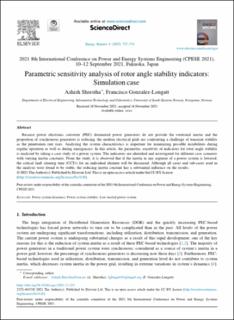Parametric sensitivity analysis of rotor angle stability indicators: Simulation case
Journal article, Peer reviewed
Published version
Permanent lenke
https://hdl.handle.net/11250/2986184Utgivelsesdato
2021Metadata
Vis full innførselSamlinger
Originalversjon
Shrestha, A. & Gonzalez-Longatt, F. (2022). Parametric sensitivity analysis of rotor angle stability indicators: Simulation case. Energy Reports, 8, 727-735. https://doi.org/10.1016/j.egyr.2021.11.233Sammendrag
Because power electronic converter (PEC) dominated power generators do not provide the rotational inertia and the proportion of synchronous generators is reducing, the modern electrical grids are confronting a challenge of transient stability as the penetration rate rises. Analyzing the system characteristics is important for minimizing possible instabilities during regular operation as well as during emergencies. In this article, the parametric sensitivity of indicators for rotor angle stability is analyzed by taking a case study of a power system. The indicators are identified and investigated for different case scenarios with varying inertia constants. From the study, it is observed that if the inertia in any segment of a power system is lowered, the critical fault clearing time (CCTs) for an individual element will be decreased. Although all cases and sub-cases used in the analysis were found to be stable, the reducing inertia constant has a substantial influence on the results.

